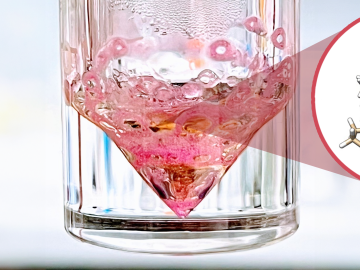
Filter News
Area of Research
News Topics
- 3-D Printing/Advanced Manufacturing (1)
- Artificial Intelligence (1)
- Big Data (1)
- Bioenergy (1)
- Biology (2)
- Biomedical (1)
- Computer Science (21)
- Coronavirus (1)
- Cybersecurity (5)
- Energy Storage (1)
- Exascale Computing (3)
- Frontier (4)
- Fusion (1)
- Grid (3)
- High-Performance Computing (6)
- Isotopes (1)
- Machine Learning (1)
- Materials (8)
- Materials Science (10)
- Microscopy (2)
- Nanotechnology (7)
- Neutron Science (5)
- Physics (6)
- Quantum Computing (31)
- Quantum Science (50)
- Security (3)
- Simulation (7)
- Summit (2)
Media Contacts

Researchers conduct largest, most accurate molecular dynamics simulations to date of two million correlated electrons using Frontier, the world’s fastest supercomputer. The simulation, which exceed an exaflop using full double precision, is 1,000 times greater in size and speed than any quantum chemistry simulation of it's kind.

Researchers used quantum simulations to obtain new insights into the nature of neutrinos — the mysterious subatomic particles that abound throughout the universe — and their role in the deaths of massive stars.
Close on the heels of its fourth summer school, the Quantum Science Center, or QSC, hosted its second in-person all-hands meeting in early May. More than 150 scientists, engineers and support staff traveled from 17 institutions to review the QSC’s progress, examine existing priorities and brainstorm new short- and long-term research endeavors.

Purdue University hosted more than 100 attendees at the fourth annual Quantum Science Center summer school. Students and early-career members of the QSC —headquartered at ORNL — participated in lectures, hands-on workshops, poster sessions and panel discussions alongside colleagues from other DOE National Quantum Information Science Research Centers.

A team from ORNL successfully characterized a coordination complex of the element Promethium. The research was supported by computational simulations of the element's electronic structure run on the IBM AC922 Summit supercomputer.

A team of researchers including a member of the Quantum Science Center at ORNL has published a review paper on the state of the field of Majorana research. The paper primarily describes four major platforms that are capable of hosting these particles, as well as the progress made over the past decade in this area.

Joseph Chapman, a research scientist in quantum communications at ORNL, was given the Physical Review Applied Reviewer Excellence 2024 award for his work as a peer reviewer for the journal Physical Review Applied.

ORNL scientists are working on a project to engineer and develop a cryogenic ion trap apparatus to simulate quantum spin liquids, a key research area in materials science and neutron scattering studies.
Luke Bertels, a Eugene P. Wigner Fellow, is helping determine ways to combine artificial intelligence and quantum computing, specifically to develop classical and quantum machine learning methods for using adaptive neural networks to study correlated molecules and chemical systems.

The Quantum Voices series is designed to share the stories of the quantum researchers and technical experts behind the Quantum Science Center’s past, present and future accomplishments. Chengyun Hua is highlighted for this edition, talking about her role in the Quantum Science Center.


